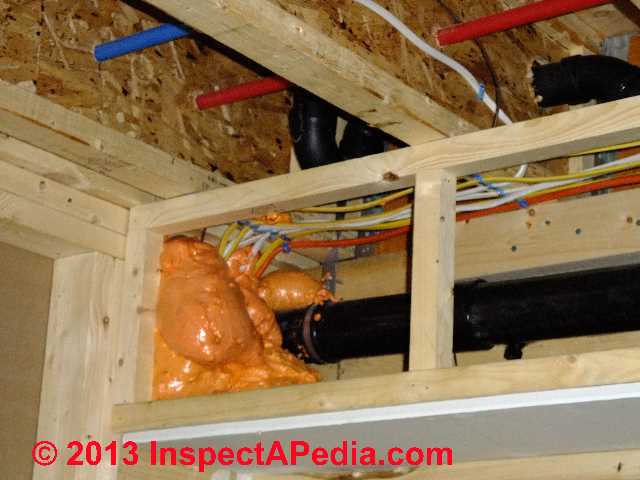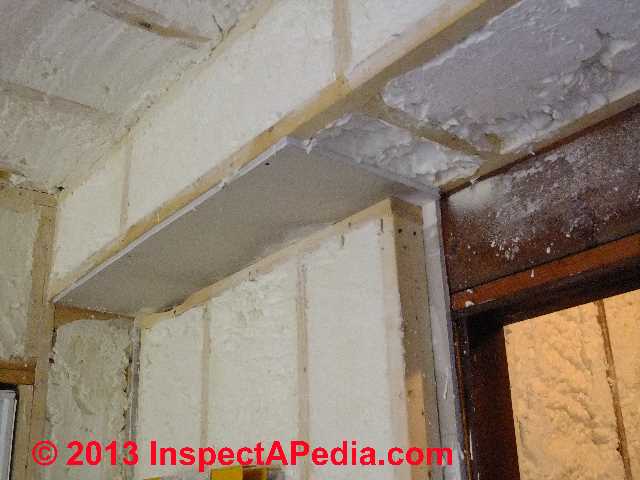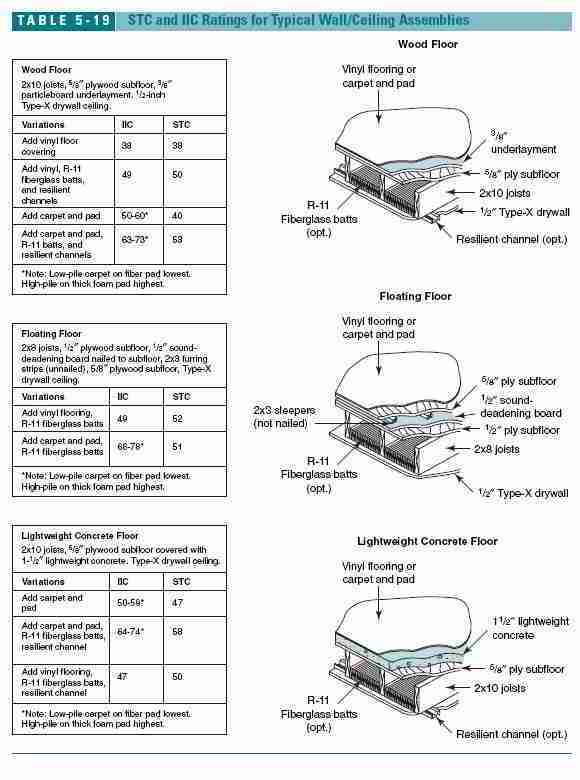 Acoustical Sealant Choices
Acoustical Sealant Choices
Tapes & sealants at poly vapor barrier lap joints
- POST a QUESTION or COMMENT about using acoustical sealants in buildings for moisture control and for sound control
Sound control in building includes isolating sound transmission pathways.
This article explains the use of acoustical sealants for sealing lap joints between polyethylene vapor barriers & sources of acoustical sealants.
Our page top photo illustrates use of a fire-retardant foam used at a drain pipe penetration through building walls and floors - a step that also improves sound insulation.
Our second photo (below) shows how we finished the plastic pipe chase with foam insulation to stop noise transmission into the occupied building space.
InspectAPedia tolerates no conflicts of interest. We have no relationship with advertisers, products, or services discussed at this website.
- Daniel Friedman, Publisher/Editor/Author - See WHO ARE WE?
Use of Acoustical Sealant for Sealing Vapor Barriers on Interior Walls
 Shown above: blown-in insulating foam around and in the pipe chase for sewer piping seals off those plumbing sounds from the occupied spaces in this building.
Shown above: blown-in insulating foam around and in the pipe chase for sewer piping seals off those plumbing sounds from the occupied spaces in this building.
The question-and-answer article about the indoor use of acoustical sealants or tape products to seal vapor barriers, quotes-from, updates, and comments an original article from Solar Age Magazine and written by Steven Bliss.
Question: where do I buy acoustical sealants for use on poly vapor barrier lap joints?
The use of acoustical sealant for sealing lap joints between sheets of polyethylene vapor barriers was mentioned in Solar Age Magazine articles (November & December 1982).
Do you have any information as to acoustical sealant brand names, suppliers of acoustical sealants, or other products suitable for sealing poly vapor barrier lap joints?
Answer: sources of non-skinning, non-curing acoustical sealants for drywall & wall penetrations
The acoustical sealant mentioned in those magazine articles is a non-skinning, non-curing sealant developed for sound control in drywall construction and in wall perforations (wall penetrations such as around electrical boxes).
One such acoustical sealant is available in one-quart cartridges from Tremco.
A variety of tapes useful in sealing polyethylene vapor barrier lap joints are available from Ideal Tape, Inc.
Their products include a clear polyethylene tape (#415) suitable for all-weather use, and a 2-mil aluminum tape (#488,487) for use with foil surfaces such as foil-faced solid foam insulating board.
And almost certainly, poly vapor barrier sealing tapes using foil, poly, or other materials are available from 3-M Corporation.
At SOUNDPROOFING MATERIAL PROPERTIES, Steve Bliss elaborates a bit about acoustical sealants used for sound proofing or noise control:
While special non hardening acoustical sealants are often specified in commercial work, any high-quality sealant that remains flexible can be effective in blocking sound transmission. Butyl, silicone, and urethane caulk can all be used.
To prevent sound leaks, use sealant around electrical boxes, plumbing penetrations, and any other penetrations in the wall or ceiling surface.
For walls with STC ratings in excess of 35, apply a flexible sealant at the joint where the drywall meets the floor.
Acoustical sealant is also used to seal around the perimeter of walls or ceilings hung from resilient channel.
Readers who need to know more about placement and sealing of vapor barriers should
see VAPOR BARRIERS & HOUSEWRAP
Here we include solar energy, solar heating, solar hot water, and related building energy efficiency improvement articles reprinted/adapted/excerpted with permission from Solar Age Magazine - editor Steven Bliss.
Original Acoustical Sealant Article:
- Q&A on use of & sources of acoustical sealants for vapor barrier lap joints - original text. Use your browser's back button to return to this page
Acoustical Sealant Standards & Codes
- ASTM C919-12, Standard Practice for Use of Sealants in Acoustical Applications, abstract excerpts from www.astm.org, retrieved 6 Nov. 2015
Walls, ceilings, and floors in building construction, especially those that are of lightweight construction, and that are designed to reduce or limit sound transmission, can have undesirable sound transmission characteristics if care is not taken to seal joints, voids, and penetrations that typically occur.
Unsealed joints, voids, and penetrations will substantially increase the sound transmission characteristics of these types of construction. By sealing them the transmission of sound can be substantially diminished by eliminating “flanking paths.”
Scope 1.1: This practice provides information for the use of sealants to reduce sound transmission characteristics of interior walls, ceilings, and floors by proper application of sealants to joints, voids, and penetrations normally found in building construction, which are commonly referred to as “flanking paths.” - ASTM E2611-09 Standard Test Method for Measurement of Normal Incidence Sound Transmission of Acoustical Materials Based on the Transfer Matrix Method
- ASTM E1050-12 Standard Test Method for Impedance and Absorption of Acoustical Materials Using a Tube, Two Microphones and a Digital Frequency Analysis System
- ASTM E2963-14 Standard Test Method for Laboratory Measurement of Acoustical Effectiveness of Ship Noise Treatments Laboratory Measurement of Acoustical Effectiveness for Marine Bulkhead and Deck Treatments
- The Acoustical Testing of Thermally Insulated Exterior Building Elements, avaliable from ASTM
- Use page bottom CONTACT link to suggest other citations
Acoustical Sealant Products & Sources
- Acoustic Geometry ASAS29 Acousti-Seal sealant (tube), ($15). available online and from building suppliers. Excerpting from the manufacturer's product description:
This professional-series acoustical sealant is a cost-effective and easy way to help stop noise leakage through joints and edges. When used properly, Acousti-Seal drastically increases the overall Sound Transmission Class (STC) of floor, ceiling, and wall assemblies. This acoustically-effective sealant bonds to wood, concrete, glass, gypsum, metal and plastic.
When dry, it will remain soft and flexible, will not crack, and is paintable. It’s great for wall/floor junctions to seal cracks and voids, heating and A/C ducts, cold air returns, exposed joints, and electrical and utility outlet boxes. Features: low VOC, low odor, non-toxic, cost-effective, essential for high-STC walls/floors, paintable, easy cleanup. - AcoustiSeal™ Acoustical Sealant # AS-29, distributed by acousticalsurfaces.com, flammability spec: ASTM E-84 – 76, Class A
Contact: Acoustical Surfaces, Inc. SOUNDPROOFING, ACOUSTICS, NOISE & VIBRATION CONTROL SPECIALISTS 123 Columbia Court North, Suite 201, Chaska, MN 55318 (952) 448-5300, Fax (952) 448-2613, (800) 448-0121 Email: sales@acousticalsurfaces.com Website: www.acousticalsurfaces.com - Franklin INternational 2892 Sound Sealant, 28-oz, Green ($12.00) sold at amazon.com and other suppliers.
- Grabber Acoustical Sealant, Grabber Construction Products, ($8.00), Website: www.grabberman.com, this is a UL 723-classifed product exceeding ASTM C834 and testing in accordance with ASTM E84, ASTM E90 and ASTM C919, the vendor says this sealant will meet NFPA Class A fire rating
- Green Glue Noiseproofing Sealant, TrademarkSound, sold at Amazon.com, product description excerpt:
Green Glue Noiseproofing Sealant exceeds LEED green building requirements, is low V.O.C., and is low odor. It can be easily cleaned while still wet with soap and water. - Latex-based caulk is also sold as an "acoustical sealant" such as Auralex, StopGap acoustical sealant caulk, sold by Zoro.com and other suppliers.
Acoustical Sound Sealant is A One-Part, Non-Flammable, Latex Based Product Formulated to Reduce Sound, Transmission in All Types of Wall Partition Systems - OSI Pro-Series SC-175 Acoustical Sound Sealant (tube) ($13.00) available online and from building suppliers. This is a water-based sealant intended to reduice sound transmission. Excerpting from a supplier of this product: soundproofcow.com who provide a product description:
OSI® Pro-Series® SC-175™ Acoustical Sound Sealant is a water-based sealant designed to reduce sound transmission in both exposed and unexposed walls and partition systems. Its’ Primary function is to achieve and maintain the specific STC (Sound Transmission Class) value of the system design. VOC compliant. - QuietSeal® Pro Acoustical Sealant (12-pack $180.00), available online and from building suppliers.
- Smoke and Acoustical Caulk, 5-gallon container, white,STL# SNS105W, produced by STI, ($125.00). This product is intended for application through a caulk gun.
- Soundseal® Acoustical Sealant, 29 oz. tube, ($12.00) available online and from building suppliers.
- St. Gobain GGSEALANT-28OZ Green Glue Noiseproofing Sealant, 28 oz, also sold at Amazon. com ($14.00),
Prices are in U.S. dollars.
...
Continue reading at ACOUSTICAL SEALANT for SOUND CONTROL more about the use of acoustical sealants for sound control in buildings or who need to know where to purchase acoustical sealants, or select a topic from the closely-related articles below, or see the complete ARTICLE INDEX.
Or see these
Recommended Articles
- SOUND CONTROL in BUILDINGS - home
- SOUND & NOISE TRANSMISSION PRINCIPLES
- SOUNDPROOFING MATERIAL PROPERTIES
- VAPOR BARRIERS & HOUSEWRAP
- VAPOR BARRIERS & CONDENSATION in BUILDINGS
- VAPOR BARRIERS & AIR SEALING at BAND JOISTS.
Suggested citation for this web page
ACOUSTICAL SEALANT CHOICES at InspectApedia.com - online encyclopedia of building & environmental inspection, testing, diagnosis, repair, & problem prevention advice.
Or see this
INDEX to RELATED ARTICLES: ARTICLE I NDEX to BUILDING NOISE DIAGNOSIS
Or use the SEARCH BOX found below to Ask a Question or Search InspectApedia
Ask a Question or Search InspectApedia
Questions & answers or comments about using acoustical sealants in buildings for moisture control and for sound control
Try the search box just below, or if you prefer, post a question or comment in the Comments box below and we will respond promptly.
Search the InspectApedia website
Note: appearance of your Comment below may be delayed: if your comment contains an image, photograph, web link, or text that looks to the software as if it might be a web link, your posting will appear after it has been approved by a moderator. Apologies for the delay.
Only one image can be added per comment but you can post as many comments, and therefore images, as you like.
You will not receive a notification when a response to your question has been posted.
Please bookmark this page to make it easy for you to check back for our response.
IF above you see "Comment Form is loading comments..." then COMMENT BOX - countable.ca / bawkbox.com IS NOT WORKING.
In any case you are welcome to send an email directly to us at InspectApedia.com at editor@inspectApedia.com
We'll reply to you directly. Please help us help you by noting, in your email, the URL of the InspectApedia page where you wanted to comment.
Citations & References
In addition to any citations in the article above, a full list is available on request.
- Solar Age Magazine was the official publication of the American Solar Energy Society. The contemporary solar energy magazine associated with the Society is Solar Today. "Established in 1954, the nonprofit American Solar Energy Society (ASES) is the nation's leading association of solar professionals & advocates. Our mission is to inspire an era of energy innovation and speed the transition to a sustainable energy economy. We advance education, research and policy. Leading for more than 50 years. ASES leads national efforts to increase the use of solar energy, energy efficiency and other sustainable technologies in the U.S. We publish the award-winning SOLAR TODAY magazine, organize and present the ASES National Solar Conference and lead the ASES National Solar Tour – the largest grassroots solar event in the world."
- Steve Bliss's Building Advisor at buildingadvisor.com helps homeowners & contractors plan & complete successful building & remodeling projects: buying land, site work, building design, cost estimating, materials & components, & project management through complete construction. Email: info@buildingadvisor.com
Steven Bliss served as editorial director and co-publisher of The Journal of Light Construction for 16 years and previously as building technology editor for Progressive Builder and Solar Age magazines. He worked in the building trades as a carpenter and design/build contractor for more than ten years and holds a masters degree from the Harvard Graduate School of Education. Excerpts from his recent book, Best Practices Guide to Residential Construction, Wiley (November 18, 2005) ISBN-10: 0471648361, ISBN-13: 978-0471648369, appear throughout this website, with permission and courtesy of Wiley & Sons. Best Practices Guide is available from the publisher, J. Wiley & Sons, and also at Amazon.com - Tremco, Tremco Global Sealants Division, 10701 Shaker Blvd., Cleveland OH 44104 - see www.tremcosealants.com/
- Ideal Tape, Inc., 1400 Middlesex St., Lowell MA 01853 - see www.abitape.com/tape/iframe_ideal.htm Tel: 1-800-284-3325
- 3-M Corporation, tape products, see solutions.3m.com/
- Our recommended books about building & mechanical systems design, inspection, problem diagnosis, and repair, and about indoor environment and IAQ testing, diagnosis, and cleanup are at the InspectAPedia Bookstore. Also see our Book Reviews - InspectAPedia.
- Best Practices Guide to Residential Construction, by Steven Bliss. John Wiley & Sons, 2006. ISBN-10: 0471648361, ISBN-13: 978-0471648369, Hardcover: 320 pages, available from Amazon.com and also Wiley.com. See our book review of this publication.
- The Journal of Light Construction has generously given reprint permission to InspectAPedia.com for certain articles found at this website. All rights and contents to those materials are ©Journal of Light Construction and may not be reproduced in any form.
- In addition to citations & references found in this article, see the research citations given at the end of the related articles found at our suggested
CONTINUE READING or RECOMMENDED ARTICLES.
- Carson, Dunlop & Associates Ltd., 120 Carlton Street Suite 407, Toronto ON M5A 4K2. Tel: (416) 964-9415 1-800-268-7070 Email: info@carsondunlop.com. Alan Carson is a past president of ASHI, the American Society of Home Inspectors.
Thanks to Alan Carson and Bob Dunlop, for permission for InspectAPedia to use text excerpts from The HOME REFERENCE BOOK - the Encyclopedia of Homes and to use illustrations from The ILLUSTRATED HOME .
Carson Dunlop Associates provides extensive home inspection education and report writing material. In gratitude we provide links to tsome Carson Dunlop Associates products and services.


